Ok, so we know that Tasmania is home to the best trout fishing in Australia, possibly the Universe.
And Tasmanians being a fairly parochial bunch, we don’t generally like to admit that we have a few of the more ‘noxious’ species. Well, noxious to us at least.
But the southern state does have some marvellous ‘coarse’ fish – redfin and tench to be precise. The English categorise redfin as a coarse fish, and as such relegate this species to a lower order, below trout and certainly below the king of fish, the Atlantic salmon.
Now in Tasmania we revere the trout as the king of fish, but that isn’t to say we don’t mind chasing other things as well in fresh water.
The exact history is a little muddled, but according to some sources redfin (Feral Deck, a publication of Tasmanian feral species) was introduced into mainland waters in 1858 and subsequently into Tasmanian waters in 1861, three years before trout were introduced.
From this beginning they have spread into many waterways in Tasmania, including the main rivers, the South Esk and the Derwent. In the South Esk system they are quite prolific in the Meander River, Macquarie River, Lake River and associated tributaries until the upper reaches, which appear to be too cold and fast for redfin.
In the lakes redfin are found in Dee Lagoon, Lake Echo, the Bradys Chain of lakes (except Bronte Lagoon) and several peripheral waters to the south and east, notably Lake Meadowbank, Craigbourne Dam and Lake Leake.
In the north of the state Brushy Lagoon is redfin central, especially big redfin.
The exact nature of the arrival of redfin into Brushy Lagoon is somewhat clouded, however most pin the introduction on a stocking of rainbow trout from a northern Tasmanian hatchery known for redfin issues. Apparently the rainbows had a few passengers, and within two years the lagoon was teeming with stunted reddies.
In an attempt to remove the redfin, which had ruined a great trout fishery, Inland Fisheries took the brave move to drain the lagoon, poison the water with rotenone (twice), re-fill it and re-stocked it with trout.
The water was closed for a season, and then with great fanfare the lake was re-opened to angling.
The first fish caught was a redfin.
So instead of doing it al over again, IFS just resigned themselves to the redfin plague and now treat Brushy as a put-and-take fishery with regular stockings of big rainbow trout and ex brood stock Atlantic salmon.
Recently on a warm afternoon, local reddie addict and Strike Tiger Lures owner Michal Rybka picked me up with two Hobie’s on top of his car – destination Brushy Lagoon. I hadn’t fished Brushy from many years, and although this trip was all about redfin, it was with a tinge of nostalgia that we pulled into the western ramp and set up. Just along from here was my favourite spot to fish the awesome mudeye migration in the early 90’s – big browns and rainbows feeding on the surface on warm evenings was the stuff of legend.
Mic has been chasing reddies at Brushy Lagoon for a while, usually using his own brand of soft plastics, especially the curl tail grub style plastics in 3” and 2”. As we peddled/paddled up to the northern part of the lagoon, Mic explained that in summer the bigger redfin start to get quite aggressive as they prepare for spawning – music to my ears, hard fighting aggressive fish should mean they’re easier to catch!
The main technique that Mic uses is a simple slow roll of the curl tail grub back to the kayak. We were fishing in shallow water festooned with snags, the redfin use the structure to ambush ‘stuff’ as it swims past. As the water is only 1m deep at best, the main technique was to cast pretty close to the snags, let it sink a bit and then a flick, pause and then the slow roll back to the angler.
After about 10 minutes there wasn’t much happening, and with the skies darkening in preparation for a forecast storm, the first of a procession of small reddies started to hit the lures. It seems that there are only two sizes of redfin in Brushy – small blokes about 30cm long and the bigger models that weight around 1.5kg.
As the regulations in Tasmania state that no redfin can be returned to the water, the storage box on the back of Mic’s kayak was starting to get pretty full with tiddly redfin.
The first of the big fish came after about 20 minutes – the take was quite soft and I initially thought it was another small redfin. Thoughts of hoicking the small fish into the kayak were abandoned as the fish pulled heaps of line from the reel and took me a merry dance around various snags, weeds and other underwater detritus before finally coming to hand.
This fish was about 1.5kg and a real thumping redfin – certainly the biggest I had caught apart from maybe a slightly bigger one in Lake Wendouree 10 years ago.
With this milestone out of the way, I switched to a surface lure – a ‘walk-the-dog’ style hardbodied lure. I remembered reading one of Roger Miles’ columns in this magazine where he’d had his clients pulling heaps of reddies on the surface walkers, and sure enough about five casts later the first one belted it.
Not a big fish, but extremely satisfying none-the-less. The retrieve I used was a steady surface walk, interspersed with five second long pauses.
While a few slashed at the lure on the retrieve, (including one pretty big trout), most fish sipped it down on the pause.
This I found to be a very exciting and intriguing was to fish, and while no big redfin were tricked using it, it was a heap of fun.
After Mic had bagged a few more big 1.5kg reddies, I switched back to the soft plastic presentation as we shifted location into some deeper, weedier water. As the afternoon eased into evening we snitched a few more 1.5kg rod-benders, with one leading Mic a merry dance around snags and the rudder of his kayak.
We both used Daiwa Interline Tournament X 7’6 rods and 6lb braid matched with 2500 series reels. With so many snaggy areas, we beefed up the ‘normal’ 6lb leader to 8lb fluorocarbon. Jig heads were mainly 1/16th Oz – no real need to get any lighter, although a 1/8th Oz is always handy if it is windy and the kayak is moving quickly.
I was tempted to use some Jackall vibes I’ve had stashed for a few years, but with so much structure down there they stayed in the tackle box.
The kayak is the perfect vessel to tackle the shallow water at Brushy. While smaller dinghies will do just fine, the ability of the kayak to get into some very shallow easily was priceless. If you were to venture onto Brushy in a boat, then an electric outboard would be invaluable.
The 3” curl tail grubs we used were essentially black with some red and gold flash through them – in the Strike Tiger catalogue they are called Black and Gold and Black Caviar. These lures are scented, which helps immensely I suspect, and similar scented plastics would also do well.
There are myriad surface lures about these days, mostly aimed at the bream market. Redfin seem to love them, so surface walkers up to 80mm should be considered. I changed the trebles for singles on mine, just to aid hook ups in the weedy water without getting fouled with weed every cast.
Weedless presentations on the soft plastics would be a great idea in the heat of summer when the lagoon gets very weedy, but come March then the weed should start to drop back.
Redfin are awesome in the fry pan, and while the skin on the bigger ones resembles toughened leather, the flesh is white and sweet. Fillet them and do them in your favourite way – mine is crumbed and done in olive oil, butter and lemon. The next lot I do will be in a tempura batter.
Brushy is a very pretty lagoon that offers some marvellous fishing for a range of freshwater species. When IFS stock this water it can get very busy and it can attract a few ‘boisterous’ individuals. Outside of those times however, Brushy is pretty quiet and peaceful, especially when the weather has been warm for a while. The trout will be off the bite, but the redfin will just be getting going.
And you should be too.
Facts
Regulations
Brushy Lagoon has several special regulations for fishing. You must hold a Tasmanian Inland Fishing Licence, even if you are not targeting trout. Bag limits apply to trout and salmon.
Total daily bag limit of 5 fish is for all species combined with 2 fish over 600mm.
Season: All year from 1 hour before sunrise to 1 hour after sunset
Method: all methods
Atlantic salmon
Minimum size: 300/600mm
Bag limit: 5 (with 2 fish over 600mm)
Brook trout
Minimum size: 300/600mm
Bag limit: 5 (with 2 fish over 600mm)
Brown trout
Minimum size: 300 mm
Bag limit: 5 (with 2 fish over 600mm)
Rainbow trout
Minimum size: 300 mm
Bag limit: 5 (with 2 fish over 600mm)

The western boat ramp at Brushy Lagoon is the perfect place to launch kayaks and small dinghies.
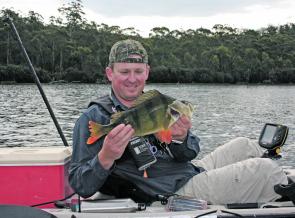
Big redfin are a feature at Brushy Lagoon – Michal Rybka with a typical 1.5kg redfin perch.

This is a perfect waterway for redfin – a mixed environment of timber, rocks and weed beds.

Big redfin go hard – this one had Mic snagged for a while until some skilled rod work got it out.
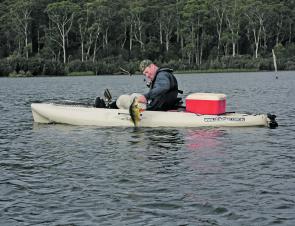
The thumb in the mouth is the trick way to land a reddie – easier than using nets from a kayak.
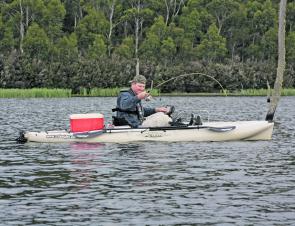
This one belted the lure right at the kayak – with quite clear water Mic watch the reddie sneak up and smash the plastic.
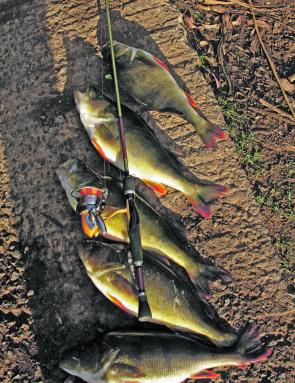
A great ‘dead meat’ shot – five 1.5kg redfin means some great fillets.

The skin is tough, so use a glove to make sure you fillet the fish and not your fingers.
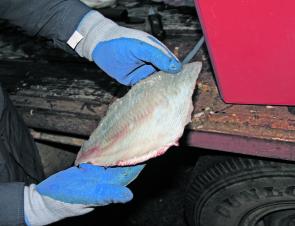
There we are – a nice clean white fleshed fillet ready for the kitchen.




